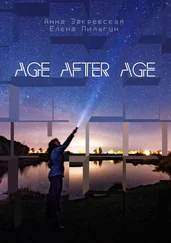“Have fun,” she told them. “I’ll talk to you tomorrow.” Tal nodded and kissed her quickly on the cheek, his gaze already off down the street.
For a moment, she and Beth watched them walk away, Dave lighting a cigarette, their lanky frames oddly similar when lit by the yellow glow of Bushwick’s old streetlights.
“What do you say we go get some dinner?” Sadie asked Beth.
“That sounds great,” she said. “Let me just run to the bathroom, okay?”
Sadie nodded. “I’ll go find Lil and say good-bye.”
Inside, the girls fought their way through the crowd, which seemed to grow thicker and wilder by the minute. Midway through, Sadie realized that she’d lost Beth, and that Lil was nowhere in sight. Left alone in the middle of the large room, Sadie surveyed the company. An unusually large number of guests wore glasses. Is our entire generation going blind ? she wondered, irritated. What a lazy metaphor . She, at least, seemed to be. For weeks, she’d been plagued with headaches, like a needle inserted into the back of her head. She’d mentioned it to Tal on Wednesday and he’d suggested she get her eyes checked. “That’s how I knew I needed glasses,” he’d said. He wore contacts now. “Oh, no, I don’t think that’s it,” she’d said. “I have perfect vision.” But the very next day, after work, they’d gone to a French movie on Court Street—she’d insisted on doing something to celebrate—and spent the whole two hours scrambling to read the strangely fuzzy subtitles. Glasses , she thought, bleh . She knew that is was “cool” now to wear glasses—so cool that (could it be?) perhaps some of the glasses that surrounded her were props—but she somehow couldn’t rid herself of her mother’s Eisenhower-era admonition against them. For women, of course. For men, they posed no threat to desirability. This was Number 367—or perhaps 54—of Rose Peregrine’s Rules for the Upkeep of the Modern Female, which began with the obvious (sweaters should only be cashmere; fur coats, mink or sable), delved into the practical (tweezers should always be slant-edged), before devolving into extreme esoterica. Sadie, unlike Lil, had a limited appetite for down-to-the-stitches descriptions of calfskin wallets with brass clasps and leather linings (“Anything else just falls apart ”), or the appropriate colors—black, brown, bone, or, on occasion, navy blue (provided one owned corresponding shoes)—and styles for handbags, which had to have a strap of at least an inch in width and should never extend below one’s waist; legs must never be shaved, only waxed (“it just grows back thicker!”); hair must never be colored at home (“you’ll ruin it!”), only at “the hairdresser’s”; skirts that ended above the knee and patent-leather shoes were suitable only for prepubescent girls (“you don’t want to look like a streetwalker!”); and faces should only— only! —be cleansed with cold cream.
The older she grew, the more Sadie found herself unconsciously following Rose’s strictures, even as she became increasingly frustrated with Rose’s adherence to them, particularly those that veered away from the areas of women’s ablutions. Rose would not, for example, eat with her coat on, or while walking down the street, or at any sort of bar, or at a cafeteria-style establishment, or, God forbid, from a tray . She had no tolerance for plastic cutlery and refused to drink water from a bottle, much less to buy water in a bottle (“We’re not in Mexico !”), but believed flocked paper luncheon napkins to be a wonderful modern contrivance. Her views on what constituted “food” did not include the cuisines of Thailand, India, Japan, Malaysia, Spain, the islands of the Caribbean (which she also refused to visit, saying this region had “no culture”), or the nations of Latin America, excepting Argentina, which was “European, actually ” and “has a very large Jewish population, you know.” Her mother, she thought lately, was becoming a character.
To her right, Caitlin Green’s husband—yet another pale, skinny man, with slitted brown eyes and black hair sticking up in messy, greasy spears—was feverishly explaining the object of some foundation he worked for or with or maybe had started himself (she knew she’d heard about it from Lil but couldn’t recall the specifics). He wore an oversized sweatshirt, the hood pulled up over his head, though the loft was quite warm. “There are all these kids who inherit money, you see,” he said now to the people assembled around him. Then he caught her eye and smiled. “Trust funds, stocks, property, huge companies, whatever. And they don’t know what to do with it. They don’t come from a culture of philanthropy. Their parents are these conservative fucks. So they inherit these portfolios with all these completely felonious investments: De Beers, Nike, McDonald’s, the Gap, Marriott. We show them how they can take that money and reinvest it in environmentally conscious, nonracist companies with safe and fair business practices. But mostly we show them how to responsibly give it all away.”
“Why should they give it all away?” asked a small woman with streaky blonde bangs and penciled-in brows, who Sadie realized was Taylor—the groupie who’d caught the bouquet at Lil’s wedding. “It’s their money,” said Taylor defensively, as though the man were threatening to take away her own fortune. “I don’t get it.”
“Why should they keep it?” asked Caitlin Green’s husband, as Sadie struggled to think of his name. “So they can buy yachts and Gucci bags? So they can widen the gap between the rich and the poor that’s destroying this country ? Why not start a foundation? Or do something cool with it?”
“Are there really that many people inheriting millions of dollars?” asked Taylor.
“More than you’d think. I bet you know tons of people who have independent incomes, but you just don’t realize it, because they don’t flaunt it. Half the artists in Williamsburg— more than half—have trust funds. Painting is expensive. The studio space. The supplies.”
“Really?” asked Taylor. “Like who? Who has a trust fund? People here? Like Lil?”
“Like her.” He jerked his thumb at Sadie, who froze, her mouth automatically forming a polite smile. “She works in publishing, right, but the interest from her trust really pays the rent. No one can actually live on an editorial assistant’s salary. Anyone who works in publishing for more than a year has an independent income.”
Sadie’s face went hot. She tucked her hair behind her ears and tried to avoid the gaze of the small crowd that was now appraising her, scrutinizing her person for signs of immense wealth. Seeing the look on Sadie’s face, he grinned. “There’s nothing to be embarrassed about. I’m the same as you. You just gotta start giving it away.”
“If I gave it away,” said Sadie tightly, “I’d have nothing to live on.”
Lil , she thought. What is wrong with her? Why had she ever told her—how did Lil get such things out of a person?—that the interest from her trust “really paid the rent.” Meaning, of course, that her salary was tiny and were it not for her small trust, she would have had to either move back home (which was not a possibility) or find a different sort of job (working at her dad’s hedge fund? My God) or simply never spend any money at all on anything but rent and food, which was impossible, as Lil knew all too well, for without certain strategic checks from Lil’s father and Tuck’s mother, Sadie knew, she and Tuck would have long been out of this loft. But that sort of help, presumably, wasn’t worth mentioning to Caitlin’s husband. No, of course not. What Lil, surely, didn’t realize—because why would Sadie tell her the banal details?—was that in Sadie’s first year, as an assistant, she’d made just $300 per week, after taxes. The rent on her little, unremarkable apartment was $750/month—more than half her salary—and it was one of the cheapest things she could find at the time (though Emily had lucked into that place in Williamsburg for $550, abandoned by a boyfriend, but she had no kitchen sink and the landlord had almost killed her).
Читать дальше












